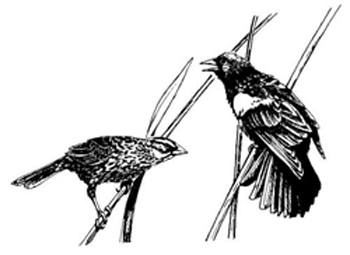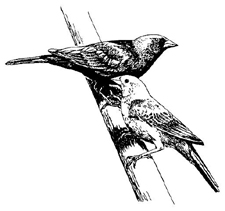Blackbirds | ICWDM | Wildlife Species Information
Figure 1. The red-winged blackbird (Agelaius phoeniceus) is the most abundant bird in North America. The black male, with red and yellow shoulder patches, is about 40% larger than the female. The female resembles a large sparrow more than a blackbird.
Introduction
The term blackbird loosely refers to a diverse group of about 10 species of North American birds that belong to the subfamily Icterinae. In addition to blackbirds, this subfamily includes orioles, meadowlarks, and bobolinks. The various species of blackbirds have several traits in common. The males are predominantly black or iridescent in color. All blackbirds have an omnivorous diet consisting primarily of grains, weed seeds, fruits, and insects. The relative proportions of these food groups, however, vary considerably among species. Outside of the nesting season, blackbirds generally feed in flocks and roost at night in congregations varying from a few birds to over one million birds. These flocks and roosting congregations are sometimes comprised of a single species, but often several species mix together. Sometimes they are joined by non-blackbird species, notably European starlings (Sturnus vulgaris) and American robins (Turdus migratorius).
The species also have many important differences in their nesting biology, preferred foods, migration patterns, and their damage and benefits to agriculture. Summarized below for each of seven species of blackbirds is information on identification, geographic range, preferred habitats, feeding habits, general biology, and damage.
Identification
The male, a little smaller than a robin, is black with red and yellow shoulder patches. The smaller female is brownish, resembling a large sparrow (Fig. 1).
Range and Habitat
An abundant nester throughout much of North America, the red-winged blackbird nests in hayfields, marshes, and ditches. Large flocks feed in fields and bottomlands. Redwings winter in the southern United States.
Food Habits and General Biology
Insects are the dominant food during the nesting season (May through July), with the diet shifting predominantly to grain and weed seeds in late summer through winter. Males and females often forage in separated flocks, with females being more insectivorous than males. Except during nesting season, redwings congregate in large nighttime roosts in marshes or woods containing up to several million birds. Annual survival rate is only about 50% to 60%. This high mortality rate is offset by a reproductive rate of 2 to 4 young fledged per female per year. Females have 3 to 5 eggs in their open-cup nests made of grasses and other vegetation. Eggs hatch after 12 days of incubation; the young grow rapidly and are ready to fledge about 10 days later. Females will often renest if their initial nest is destroyed.
Damage to Crops
Red-winged blackbirds can cause considerable damage to ripening corn, sunflower, sorghum, and oats in the milk and dough stages, and to sprouting and ripening rice. These birds provide some benefits by feeding on harmful insects, such as rootworm beetles and corn earworms, and on weed seeds, such as Johnson grass.
Fig. 2. The common grackle (Quiscalus quiscula) is an iridescent blackbird, larger than a robin, with a long, keel-shaped tail.
Common Grackle
(Quiscalus quiscula)
- Identification
An iridescent blackbird larger than a robin, the common grackle has a long keel-shaped tail. The male, slightly larger than the female, has more iridescence on the head and throat (Fig. 2).
- Range and Habitat
A common nester throughout North America east of the Rockies, the common grackle nests in shelterbelts, farmyards, marshes, and towns. Flocks feed in fields, lawns, woodlots, and bottomlands. These birds winter in the southern United States, often in association with redwings, cowbirds, and starlings.
- Food Habits and General Biology
The common grackle’s diet is somewhat similar to that of the redwing, but the grackle is more predatory. Its diet occasionally includes small fish, field mice, songbird nestlings, and eggs. Grackles have a larger, stronger bill than redwings, allowing them to feed on acorns and other tree fruits in winter. Grackles often roost with red-wings, but are more partial to roosting sites in upland deciduous or pine trees. Reproductive and survival rates are similar to redwings.
- Damage to Crops;
Damage is similar to that of redwings; however, grackles will feed on mature field corn in the dent stage, removing entire kernels from the cob. Also, grackles will pull up sprouting corn. Great-tailed Grackle (Quiscalus mexicanus)
- Identification;
This species is similar to the common grackle but with a much larger tail. The male is slightly smaller than a crow; the female is smaller and browner than the male.
- Range and Habitat
An abundant year-round resident in coastal and southern Texas, the great-tailed grackle nests in colonies in shrubs or trees, sometimes in association with herons and egrets. The flocks feed around farms, pastures, and parks.
- Food Habits and General Biology
The diet is omnivorous: insects, aquatic organisms, eggs from nesting birds, fruits, and grains. Reproductive and survival rates are similar to those of redwings.
- Damage to Crops
These birds damage all types of fruits and melons, although the loss is generally minor. In recent years, however, their damage to citrus crops in localized areas of the lower Rio Grande Valley of Texas has been substantial. Great-tails peck the citrus fruit skin, creating blemishes or holes.
Blackbirds | ICWDM | Wildlife Species Information
Brown-headed Cowbird
(Molothrus ater)
Identification
The cowbird is the smallest blackbird. The male is black with a brown head and the female is gray. Both sexes have sparrow like bills (Fig. 3).
Figure 3. The brown-headed cowbird (Molothrus ater), smallest of the blackbirds, often feeds in close association with livestock. The female cowbird (lower) lays her eggs in the nests of other birds.
Range and Habitat
Cowbirds occur in spring and summer throughout much of North America. Flocks feed in pastures and feedlots, and are often associated with livestock. Cowbirds winter in the central to southern United States, often roosting with redwings, grackles, and star-lings.
Food Habits and General Biology
The diet of cowbirds consists predominantly of weed seeds and grains, and less than 25% insects. Cowbirds do not build nests or incubate eggs; the female lays her eggs in nests of other songbirds, the only North American songbird to do so. Females deposit 1 or sometimes 2 eggs per host nest, laying up to 25 or more eggs per nesting season.
Damage to Crops
This species can cause damage to ripening sorghum, sunflower, and millet. Cowbirds consume some livestock feed, but often glean waste grain and seed from dung. Overall damage is usually minor.
Yellow-headed Blackbird
(Xanthocephalus xanthocephalus)
- Identification
A robin-sized bird, the male has a striking appearance with his black body, conspicuous yellow head and breast, and a white wing patch in flight. The female is smaller and browner, with a yellowish throat and breast.
- Range and Habitat
Yellowheads are locally abundant nesters in deep-water marshes of the northern Great Plains and western North America. They feed in agricultural fields, meadows, and pastures during late summer and fall, sometimes in association with redwings or other blackbirds. They winter farther south than other blackbirds, primarily in Mexico.
- Food Habits and General Biology
The diet is similar to that of redwings; yellow heads eat primarily insects during the nesting season and grains and weed seeds at other times. An early migrant, the yellow head leaves the northern plains by September. Survival and reproductive rates are similar to those of redwings.
- Damage to Crops
Yelloheads cause localized but generally minor damage to ripening corn, sunflower, and oats, often in association with redwings. They often leave the northern prairie regions by the time corn and sunflower are ripening in autumn.
Brewer’s Blackbird
(Euphagus cyanocephalus)
- Identification
A robin-sized bird, the male is all black with whitish eyes; the female is brownish gray with dark eyes.
- Range and Habitat
A familiar bird in the northern Great Plains and western North America, the Brewer’s blackbird nests in a diversity of habitats. It prefers pastures, lawns, and agricultural lands for feeding. It is a winter migrant in the central and southern Plains states, sometimes roosting with other blackbird species.
- Food Habits and General Biology
The diet is about two-thirds grain and weed seeds, and one-third insects and other animal matter. They feed in flocks on waste grain and weed seeds and nest in colonies. Reproductive and survival rates are similar to those of redwings.
- Damage to Crops
Brewer’s blackbirds cause generally minor damage to oats, fruit crops, and livestock feed and consume large numbers of noxious insects during the summer months.
Rusty Blackbird
(Euphagus carolinus)
- Identification of Range and Habitat
Rusty blackbirds nest in northern swamps and muskegs (bogs) through-out Canada, Alaska, and northern New England. They migrate in winter to the southern United States from the Atlantic coast to east Texas.
- Food Habits and General Biology
The diet of rusty blackbirds is more insectivorous than that of other blackbirds. Over 50% of their food is animal matter. Grain (gleaned from harvested fields in fall and winter), weed seeds, and tree fruits are also eaten. In winter, rusty blackbirds prefer swampy areas and river bottoms. They often roost with other blackbird species.
- Damage to Crops
This species does little damage to crops.
Richard A. Dolbeer Project Leader Denver Wildlife Research Center USDA-APHIS-Wildlife Services Sandusky, Ohio 44870



